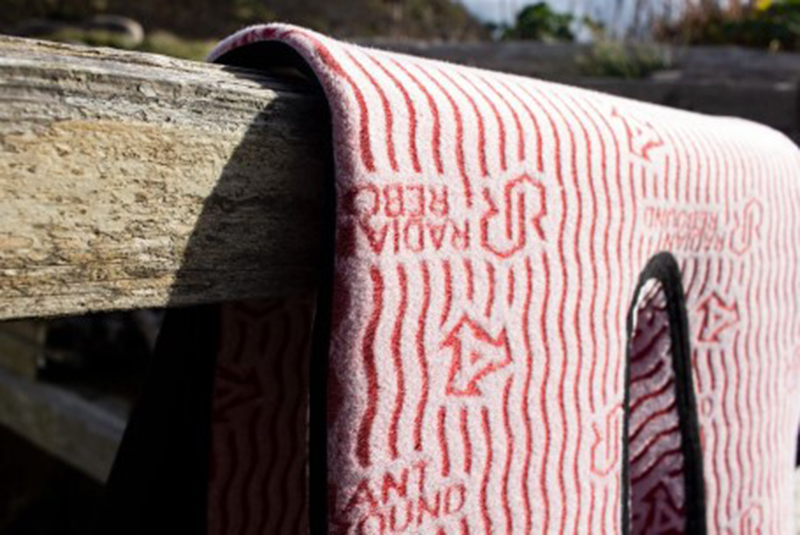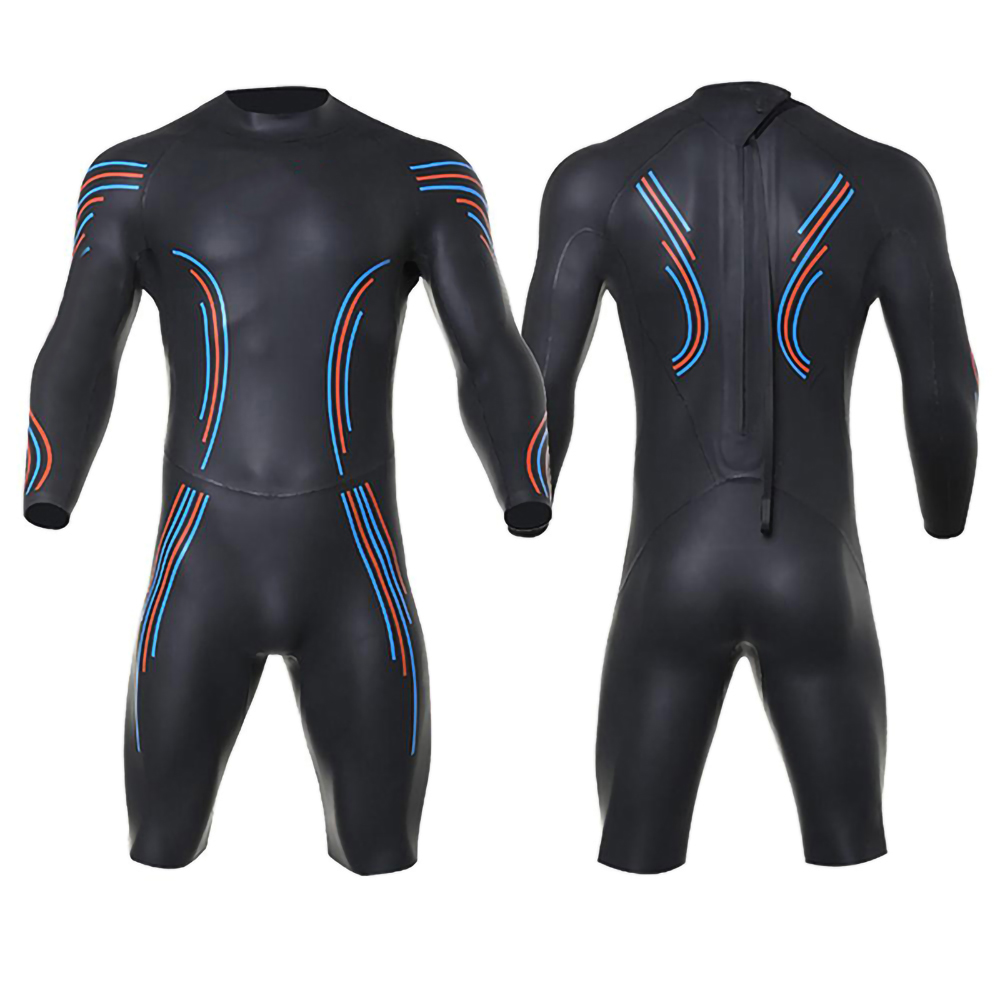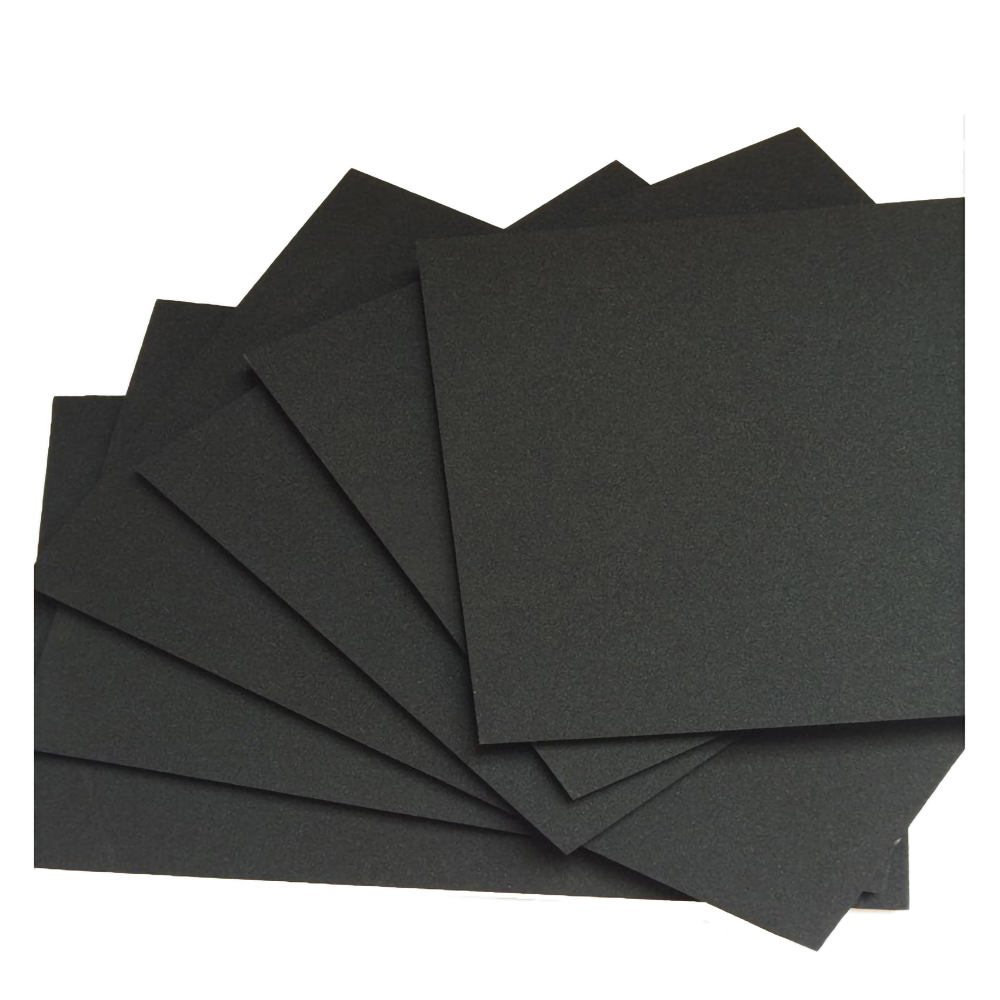Wetsuit material – If the Kevlar is the best material for reinforcement pad?
As for this issue, it should be not. This is because we also need consider the stretch for a wetsuit, Though Kevlar is so perfect durable, but the stretch is not so good. Therefore, if the wetsuit material is so perfect, such as Yamamoto neoprene, then Kevlar is not suggested to use together in order to avoid breaking easily in the seam line between these totally different stretch materials.
Wetsuit material - What is the difference between dyeing and digital printing?
1) Dyeing: put the cloth into a pool that is with chemical agent of relevant color to dye, it means we can dye many cloths once, but this action is only one color once, and need to be higher cost if cloth is little.
2) Digital printing: put the cloth on a printing platform, then print the color we would like. it is like that we print photo by printer. It means we should print the cloth panel with any multi-colors style one by one, so the area of cloth should be limited by the digital printer
Wetsuit material - What is the Namliong neoprene?
Namliong neoprene is made out of petromoneda from Taiwan. This polymeric foam is close-cell sponge. Including Chloroprene Rubber (so-called neoprene), Styrene butadiene rubber (SBR).
The neoprene have the good performance of warm-keeping, water-proof and cushion. The sliced foam can be laminated with various fabrics for the consumer finished products or can be die cut for the industrial use.
Its applications:
Consumer-use applications: Wetsuit, drysuit, swimwear, neoprene fitness suit, medical supports, sports support, shoes, bags and so on.
Industrial-use applications : Gasket or seal for heat insulation, shock-absorption in machine, automobile or ship.
Wetsuit material - What is the Jako neoprene?
Jako neoprene is made out of Limestone based CR polymer from Korea. Limestone, consisting of over 99% calcium carbonate, is originally for construction cement but made an enormous progress with a wider adoption to a number of industrial fields even with extension to daily life sectors as well, `thanks to its environment-friendly property. It takes the opportunity to make the products be more particular and valuable one by accepting the highest purity of limestone base neoprene.
As Jako's 30-years history certifies the unbeatable quality ranging from ultra elongation Neoprene to high dense ones. Therefore, its products have some many advantages as show below:
1) Environment-focus Limestone base
2) Sophisticatedly classified Neoprene by its function.
3) Ultra soft grade with improved durability.
4) High density foam designed for durability-required products.
Wetsuit material - What is the glide skin neoprene?
Glide skin neoprene is a type of single lined neoprene. and it is similar to smooth skin neoprene, but it's a little bit more slippery as it has another coating on the surface of the neoprene. So that it is often used on chest and back panels of surfing wetsuits to be against windchill. This can let you last longer time for surfing.
Wetsuit material - What is the surface line up of neoprene?
Different wetsuits are made of kinds of neoprene for different situations. Therefore, neoprene material suppliers often provide varies of neoprene surfaces. There are some common surfaces to be used usually.
1. Smooth skin, its surface is so smooth, so that it can reduce the friction resistance from wind or water. Therefore, it is often for surfing wetsuit, freediving wetsuit, triathlon wetsuit.
2. Cell skin, its surface is with many small holes that can keep warm better if the neoprene is closed to our body so much and the flexibility is perfect. Therefore, it is often for spearfishing wetsuit.
3. Shark skin, its surface is full of reinforced dots. then the strength is so perfect. Therefore, it is often for some wetsuits needed to reinforce.
4. Cross Mesh Skin, its surface is with checkered reinforcement, then the strength is so perfect but less than shark skin. Therefore, it is often for some wetsuits needed to reinforce.
Wetsuit material - How is Yamamoto BRS neoprene?
Yamamoto BRS neoprene is a combination material consist of SCS, ultra thin limestone CR, titanium-a, jersey. And its thickness is only 0.3-0.5 mm. This special material is usually used in making triathlon wetsuits, as Ultra-thin neoprene has good heat-retention properties than normal swimsuits
Wetsuit material - How is Yamamoto SCS neoprene?
Yamamoto SCS neoprene is an additional process coating above smooth skin surface made by Yamamoto company, the full name of SCS is called “Super Composite Skin”. This special material is usually used in making triathlon wetsuits or some surfing wetsuits, as it will reduce the friction during putting on and taking off (wetsuits) and alleviate water resistance.
Yamamoto SCS Material Composition
Wetsuit material - How is Spandex cloth used in wetsuit manufacturing
Spandex cloth is another flexible material used to make wetsuits and is often used as a replacement for nylon. Spandex is especially popular in the seams of wetsuits. Wetsuits made entirely of spandex do exist, but only in warmer climates because it doesn't hold heat anywhere like neoprene.
Wetsuit material - How is Nylon cloth used in wetsuit manufacturing
Nylon cloth is commonly found in the lining of most popular wetsuits. It is an extremely durable material that helps protect weaker wetsuit materials from damage and holds wetsuit parts together. The main disadvantage of using nylon is reduced flexibility if the neoprene is so perfect, which makes wetsuits more restrictive.
Wetsuit material - What is Jersey cloth?
Jersey cloth is a very soft material, suitable for sensitive skin, which is why it is often used to make the inner lining of wetsuits. A jersey is sometimes used on the outside of a wetsuit, usually a wetsuit with a camouflage pattern. Jersey liners can also be reinforced with other materials, including titanium.
Wetsuit material - What is Yulex natural rubber
Yulex natural rubber is made from guayule plant by Yulex Corporation and it is FSC® certified. It is produced by trees that absorb carbon throughout their life span. Switching to hevea reduces the CO₂ emissions from one wetsuit by up to 80%.
In 2012, it was used into diving suit by Patagonia for the first time. but until now, it is also not to expand to all over the world as other wetsuit manufacturers can not buy Yulex material.
Yulex is a good neoprene alternative for surfers, but not so much for divers because Yulex isn't very pressure resistant and the pressure of water will shorten its lifespan considerably. Therefore, it can be said that the material improvement of diving wetsuits is much more difficult than surfing wetsuits or triathlon wetsuits, which is why diving wetsuits are counted separately in industry statistics.
Wetsuit material - What is Dope dyeing (wetsuit laminated fabric)
Dope dyeing for wetsuit laminated fabric is a dyeing technique used to dye synthetic fibers such as acrylic, nylon and polyester. In dope dyeing, pigments are added to a liquid polymer solution prior to extrusion of the synthetic fibers. method. Traditional fiber dyeing entails applying color to the fiber surface without coloring it.
In dope dyeing, colored pigments become part of the fiber, which improves color fastness and reduces color deviation compared to traditional dyed fibers.
Compared with traditional dyeing, dope dyeing reduces water consumption by 80%, dye consumption by more than 20%, use of alkaline and other chemical reagents by 80%, and electricity consumption by 7%.
Wetsuit material - Four common types of wetsuit neoprene processing
Neoprene will be processed before the wetsuit is made. There are four common processing methods:
Laminating. It is to glue the fabric to the surface of the "neoprene sponge" to increase the surface strength (tear resistance and abrasion resistance), so that the neoprene sponge has the characteristics of the fabric. This is the most conventional machining process. Application: Widely used in the production of various related products, commonly used fabric types are polyester, nylon, spandex, … etc.
Coating. It is to coat the surface of the "neoprene rubber sponge" with polyurethane polymer material to increase the surface strength and smoothness, this is to avoid the accumulation of water and reduce the friction in the water, so that the neoprene sponge will have more colors. Additional titanium can be added to the "coating" to improve thermal performance. Application: Usually used to make high-end products, such as triathlon wetsuit and spearfishing wetsuit etc.
Embossing. It is embossed on the surface of the "neoprene rubber sponge" with different patterns of molds, so the surface will have different patterns to increase the surface strength, anti-slip, and reduce friction in water. It also looks more beautiful. Application: "Embossed Neoprene Fabric" is often used to make products
Perforation. It uses different shapes of molds to punch holes on the "neoprene rubber sponge" to form holes of different shapes and sizes to increase breathability, reduce weight, and enhance the sense of design. There are two methods: "Visible perforation" is lamination of a neoprene sponge with fabric and then perforated, the holes are visible. "Inner perforation" is where the neoprene sponge is perforated and then the fabric is laminated so that the holes are invisible. Application: It is often used to make products that require increased breathability or appearance.
Wetsuit material - Thermal lining of wetsuits
The lining is the insulating layer on the inside of the wetsuit and is mainly used for medium and high-grade wetsuits. The lining material should be stretchy and lightweight, and be water repellent and quick-drying so it doesn't become a heavy, wet fleece after wearing.
When it's cold, the thermal lining will keep you warm. However, even though these materials have become lighter and more flexible, they still reduce the flexibility of the wetsuit.
If you do need a wetsuit with a thermal lining, the area covered by each wetsuit will vary. Generally, the more you're willing to pay, the more coverage you'll get. Some wetsuits are not lining at all, such as entry-level or summer suits, but some wetsuits will have full lining (1), some just the legs and torso (2), some may only have a panel on the front (3) to better protect the core area.
Wetsuit material - What is the difference between Spandex, Lycra and Elastane?
In our wetsuit material, are spandex, lycra and elastane all the same?
The material itself is elastane, but different names are used depending on the country and the brand that makes it.
For example, people living in the US usually refer to elastane as spandex, but the rest of the world calls it elastane unless they're referring to a specific brand name. E.g. Lycra is DuPont's product for spandex fibers. Lycra® is a trademark and brand name of DuPont Company. There are other companies that also produce spandex fibers, such as Elastam, Elaspan, Creora or Dorlastan, and so on.
So, no matter what it's called, elastane is still elastane.
Wetsuit material - What is smooth skin neoprene
Smooth skin neoprene: one side is the cell, the other side is the surface of the sponge sheet, The smooth skin is in the outside and has excellent strength and smoothness, but the stretchy performance is not as good as the neoprene cell. Because of being good at repelling water and the wind.
In general, "Smooth Skin" neoprene is used for core region of the wetsuit to prevent the wind and water from cutting through and it is to manufacture the triathlon wetsuit. However, it is not as durable as the neoprene with nylon line, and it is much more easily to tear and rip when we wearing.
Wetsuit material - Yamamoto neoprene introduction
1) science and technology fabric from the essence of breakthrough
triathlon wetsuit technology is mainly manifested in glue and tailoring and edition type, and the content of science and technology mainly comes from the use of materials, almost top of the world triathlon brand invariably chose Japanese Yamamoto company of neoprene as production triathlon wetsuit materials necessary。
2) low resistance performance
the technical coating of Yamamoto SCS makes the resistance coefficient of the material in water 0.021, while the resistance coefficient of the generic brand of neoprene is 4, which is an order of magnitude difference.
3) tensile capacity
the average tensile capacity of the Yamamoto neoprene is 7 times that of the ordinary neoprene stretching ability, which affects the fit and comfort of the players in their clothing buoyancy performance.
4) buoyancy performance
the average buoyancy of Yamamoto neoprene is 30% higher than the average brand. buoyancy can have a big impact on the speed of a player and it floats more smoothly in water, you can swim faster and more effortless.
Wetsuit material - What is limestone neoprene
It was Yamamoto Corporation from Osaka, Japan that first developed neoprene from limestone—and with no oil at all—thanks to an abundance of pure limestone close by in the mountains of Japan (their reserve of limestone is estimated to be sufficient for the next 3,000 years). Yamamoto has set the standard for quality and innovation in the neoprene industry with their advanced manufacturing techniques, leading to the creation of a limestone neoprene that has a completely independent cell structure and multi-directional stretch capacity.
The calcium carbonate, found in the limestone, is used as the base with chloroprene by a process of polymerization to produce limestone based-chloroprene rubber chips.
What are the advantages of limestone neoprene?
Limestone neoprene has a high micro-cell structure. These are independent closed cells (bubbles basically) within the neoprene that are packed together at an extremely high density. Oil-based neoprene has a cell penetration of 60-70%, whereas limestone neoprene has a 94% cell penetration. What this means in simple terms is that limestone neoprene has a lot more air bubbles inside the rubber than other brands (over 30% to be exact), and is way less dense than oil-based neoprene.
Because of this micro-cell structure, limestone neoprene provides several serious distinct advantages to the functionality of wetsuits compared to the traditional oil-based neoprene:
It is impermeable.
It is lighter in weight.
It is warmer.
It is more durable.
It is stretchy.
Wetsuit material - What is neoprene types
There are several different grade Neoprene materials for different application: SBR, CR and SCR.
| Name | Features | Neoprene Composition | Application |
| SBR | A synthetic rubber produced by polymerization of styrene and butadiene. It has excellent cushioning and warmth retention, low price but poor compression resistance. | Styrene Butadiene Rubber | Wetsuit, bags, gloves, covers, koozie, mouse mat, etc. |
| CR | A synthetic rubber produced by polymerization of chloroprene. It has excellent elasticity, strength, pressure resistance and warmth retention, seawater resistance, chemical resistance and flame retardancy. | Pure Neoprene. Chloroprene Rubber | High-end wetsuits and clothes. |
| SCR | A mixture of CR and SBR and is widely used in the production of various related products as lower price than CR and better elasticity than SBR. | Mix of CR & SBR | Gloves, pants, wetsuits. etc. |
For the difference between the high-end material ( CR ) and the basic material is elasticity. High-end material is softer, more resilient, and fits even better after wearing, and keep the body warmer. Basic materials does not stretch as CR and more fragile.
In addition, the high-end material is more expensive. The price of "CR" + "Super Stretch fabric" 5-6 times that of "SBR" + "Nylon fabric" in general, although their surfaces are similar. Some of rubber companies such as Sheico and Nam Liong developed high-end SCR that has good function. It is not as good as CR but price is low.
Wetsuit material - What is neoprene
The completed chemical name of this material is actually called polychloroprene. DuPont renamed to neoprene when choosing a trade name for the material and the name stuck. Nowadays, all polychloroprene materials are simply referred to be as neoprene.
What is it? It is an elastic synthetic rubber material that has very good insulating properties due to the millions of tiny air bubbles (microcells) inside the material. These cells are filled with air or nitrogen (better insulators). So that they make up the basic insulation of neoprene to keep warm inside. This is why the wetsuits are also made of this material.
Devote to
diving equipment
one-stop customization
12 years experience
Best Sellers
Experience in Water
Guarantee on Wetop
Tel.: +86 592 6536 876
E-mail: enquiry@wetopsports.com
Copyright © Xiamen Wetop Sports Co., Ltd. All Rights Reserved | Sitemap
Quick Links
Company

Dear Friend
Thank you for your enquiry. We are looking forward to be your fantastic partner soon.
Due to different email systems, If you don't receive our email in the next 2 working days after submitting,
1) Pls kindly search the spam box in your email first,
2) If also not, Pls kindly let me know by leaving message here again, sending email or other contact info. Such as FB, linkedin.
Page automatically Jump waiting time : 30
Enquiry info sending...